Here are two different views of the ramparts of Maiden Castle, which is one of the biggest hillforts in Southern England. Imagine Sergeant Troy and Bathsheba Everdene here, as he dances around her with lightning strikes of his sword until he cuts a lock of her hair. Her initial dislike of him becomes infatutation . . . read 'Far from the Madding Crowd' for the rest of the plot!

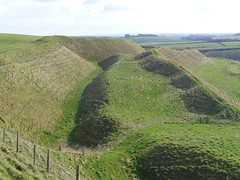 William Barnes' statue still stands by St Peter's Church. The Dorset poet was born in 1801 and died in 1886. He was born near Sturminster Newton, in the North of the county, and graduated as a Bachelor of Divinity from Cambridge in 1848. He moved to Came Rectory, to the South of Dorchester, in 1862. He tutored the young Thomas Hardy, passing on his love of language. He always held that the form of dialect spoken in Wessex had a close relationship to that spoken in Anglo-Saxon England. The following link may be of interest :
William Barnes' statue still stands by St Peter's Church. The Dorset poet was born in 1801 and died in 1886. He was born near Sturminster Newton, in the North of the county, and graduated as a Bachelor of Divinity from Cambridge in 1848. He moved to Came Rectory, to the South of Dorchester, in 1862. He tutored the young Thomas Hardy, passing on his love of language. He always held that the form of dialect spoken in Wessex had a close relationship to that spoken in Anglo-Saxon England. The following link may be of interest :http://www.dorsetshire.com/poets.html
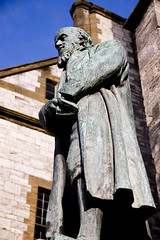 I used to work just across the Park from this clocktower, and spent many sunny summer lunch-hours eating my sandwiches and reading a book here. I always saw it in my mind's eye, as it used to be in Thomas Hardy's "Mayor of Casterbridge".
I used to work just across the Park from this clocktower, and spent many sunny summer lunch-hours eating my sandwiches and reading a book here. I always saw it in my mind's eye, as it used to be in Thomas Hardy's "Mayor of Casterbridge".
The market was another happy hunting ground. I still have some lovely little bits of blue and white china I bought on a stall here, for about 50 pence each. Several of them are on display on my long shelf in the bathroom.
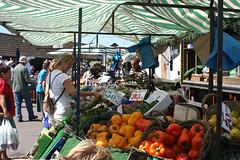
If you are ever in Dorchester, pop into the County Museum, which has the most amazing collections, and Hardy's Study has been faithfully reproduced:
http://www.dorsetcountymuseum.org/galleries.htm
Here's the Market Cross (top of South Street if my memory serves me well):
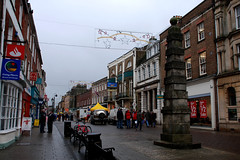
Below is a view of the Piddle Valley, where I lived for a while in my 30s. Good for walking. You can just imagine Tess walking through this cornfield . . .
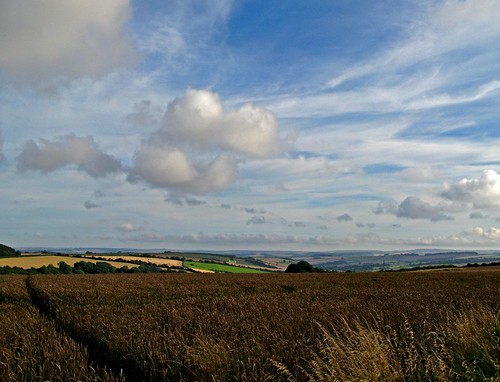 Thomas Hardy's birthplace - the lovely cottage at Higher Bockhampton, on the edge of his Egdon Heath.
Thomas Hardy's birthplace - the lovely cottage at Higher Bockhampton, on the edge of his Egdon Heath. Hardy's heart was buried in a casket inside this imposing tomb in Stinsford churchyard, beside the burial places of his ancestors. Well - perhaps just the casket was, as there is a literary rumour that the heart in the opened box was placed on the table at his home, and the cat ate it! Believe what you will. The rest of him resides in Poet's Corner in Westminster Abbey.
Hardy's heart was buried in a casket inside this imposing tomb in Stinsford churchyard, beside the burial places of his ancestors. Well - perhaps just the casket was, as there is a literary rumour that the heart in the opened box was placed on the table at his home, and the cat ate it! Believe what you will. The rest of him resides in Poet's Corner in Westminster Abbey.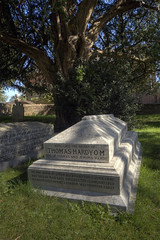 This is Hangman's Cottage in Dorchester, tucked away at the back of the town by the River Frome. The town's Hangman really did live there too. Here Hardy peeped through the window and saw the hangman cheerfully eating his evening meal the night before a hanging. It was seeing such a public hanging of a woman (Elizabeth Martha Browne, who was the last woman to be hung in Dorchester), which lingered in Hardy's mind and he made that the ending for that most forsaken of all his heroines, Tess. He was 16, and he afterwards wrote: "what a fine figure she showed against the sky as she hung in the misty rain, and how the tight black silk gown set off her shape as she wheeled half round and back". http://www.richard.clark32.btinternet.co.uk/browne.html
This is Hangman's Cottage in Dorchester, tucked away at the back of the town by the River Frome. The town's Hangman really did live there too. Here Hardy peeped through the window and saw the hangman cheerfully eating his evening meal the night before a hanging. It was seeing such a public hanging of a woman (Elizabeth Martha Browne, who was the last woman to be hung in Dorchester), which lingered in Hardy's mind and he made that the ending for that most forsaken of all his heroines, Tess. He was 16, and he afterwards wrote: "what a fine figure she showed against the sky as she hung in the misty rain, and how the tight black silk gown set off her shape as she wheeled half round and back". http://www.richard.clark32.btinternet.co.uk/browne.htmlHere is a link to some more photos of the cottage:
http://www.weymouth-pictures.co.uk/dor/dor/han/pic_hangmanscottage.htm
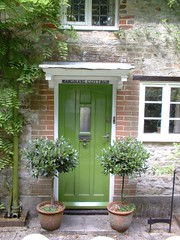
This is Thomas Hardy's statue at the top o'town. He would notice some changes now from his time . . .
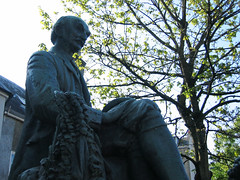


4 comments:
Another wonderful day out. So much to think about and follow up on. You give me all these rabbit trails to go down (as if I don't come up with enough of my own).
Thank you again. Believe it or not, I have never read "Far from the Madding Crowd. There's another for my list.
Nancy
Hi Jennie. I went and looked at the other cottage pictures. I think my mistaken picture of a cottage was that it had to be tiny. Some of the cottages I see are huge! Is cottage simply the name of a style? What is the roof made of on these? I'm assuming the materials now are different than the original.
Nancy
I've never had to define a cottage before. It can be tiny - or it can be a more substantial size. A thatched roof generally defines it (not that many thatched houses). Cob walls - that is, walls made of mud, straw, animal dung etc mixed together and built up (I suppose a bit like adobe walls?) Small windows. Originally built for the rural poor. The ones shown in Helen Allingham paintings look wonderfully picteuresque from the outside but you would probably not have wanted to live in them - crawling with cockroaches, sometimes just earthen floors, no sanitation - you went down to the privy at the end of the garden for that. Water carried from the well. My ex-husband's Dorset aunty lived in one not much better - only cold running water which had to be pumped up into the sink, and no hot water and no bathroom. Loo in a wriggly tin shed up the garden . . .
I'm glad you are enjoying the rabbit trails!
Thanks for your patience to answer my questions.
Nancy
Post a Comment